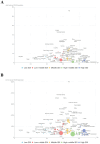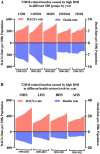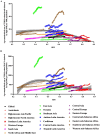Global, regional, and national burden of type 2 diabetes mellitus caused by high BMI from 1990 to 2021, and forecasts to 2045: analysis from the global burden of disease study 2021
- PMID: 39916706
- PMCID: PMC11798972
- DOI: 10.3389/fpubh.2025.1515797
Global, regional, and national burden of type 2 diabetes mellitus caused by high BMI from 1990 to 2021, and forecasts to 2045: analysis from the global burden of disease study 2021
Abstract
Objective: To produce estimates of the global burden of type 2 diabetes mellitus (T2DM) caused by high body mass index (high BMI) and its impact for 2021 and projections for 2045.
Methods: We downloaded data from the Global Burden of Disease Study 2021(GBD 2021) to estimate the disease burden of T2DM caused by high BMI. Secondary analyses were performed by year, age, gender, region, and socio-demographic index (SDI).
Results: Globally, the all-ages number of T2DM-related deaths has increased significantly from 238.1 thousand to 723.7 thousand, representing a 203.9% increase since 1990. And the all-ages number of T2DM-raleted DALYs has raised from 10.4 million to 39.3 million, increased by 276.7% from 1990. The burden was expected to continue to increase to 1296.7 thousand by 2045 for all-ages number of deaths, and 85.5 million by 2045 for all-ages number of DALYs. The curves of T2DM-related burden showed an intersection for different genders around the age of 60, beyond which women exhibit a higher burden, compared to men. The disease burden of T2DM caused by high BMI shows a significant upward trend across all SDI groups, with a heavier burden on women, especially in the postmenopausal female population. In 2021, among the 204 countries and territories, the top 3 largest number of T2DM-related burden caused by high BMI occurred in China, India, and United States. The top three countries with highest T2DM-related rate caused by high BMI were Fiji, Marshall Islands, and Kiribati.
Conclusion: Our study reveals that the disease burden of T2DM caused by high BMI is significantly increasing and is expected to continue rising in the future. Women bear a heavier burden, particularly postmenopausal women, and there are significant differences in the disease burden across different geographical regions, and socioeconomic statuses. Targeted considerations and specific strategies are essential to address these disparities, thereby improving public health and reducing the burden.
Keywords: deaths; disability-adjusted life years (DALYs); global burden of diseases (GBD); high body mass index (high BMI); socio-demographic index (SDI); type 2 diabetes mellitus (T2DM).
Copyright © 2025 Huang, Wu, Ni, Xu and He.
Conflict of interest statement
The authors declare that the research was conducted in the absence of any commercial or financial relationships that could be construed as a potential conflict of interest.
Figures






Similar articles
-
Global burden of type 2 diabetes mellitus from 1990 to 2021, with projections of prevalence to 2044: a systematic analysis across SDI levels for the global burden of disease study 2021.Front Endocrinol (Lausanne). 2024 Nov 8;15:1501690. doi: 10.3389/fendo.2024.1501690. eCollection 2024. Front Endocrinol (Lausanne). 2024. PMID: 39583961 Free PMC article.
-
Global, regional, and national burden of mortality and DALYs attributable to high body mass index from 1990 to 2021 with projections to 2036.BMC Public Health. 2025 Jun 3;25(1):2053. doi: 10.1186/s12889-025-23237-7. BMC Public Health. 2025. PMID: 40462096 Free PMC article.
-
Burden of disease scenarios for 204 countries and territories, 2022-2050: a forecasting analysis for the Global Burden of Disease Study 2021.Lancet. 2024 May 18;403(10440):2204-2256. doi: 10.1016/S0140-6736(24)00685-8. Lancet. 2024. PMID: 38762325 Free PMC article.
-
The global burden of disease attributable to high body mass index in 195 countries and territories, 1990-2017: An analysis of the Global Burden of Disease Study.PLoS Med. 2020 Jul 28;17(7):e1003198. doi: 10.1371/journal.pmed.1003198. eCollection 2020 Jul. PLoS Med. 2020. PMID: 32722671 Free PMC article.
-
Pediatric Type 2 Diabetes: Prevention and Treatment Through a Life Course Health Development Framework.2017 Nov 21. In: Halfon N, Forrest CB, Lerner RM, Faustman EM, editors. Handbook of Life Course Health Development [Internet]. Cham (CH): Springer; 2018. 2017 Nov 21. In: Halfon N, Forrest CB, Lerner RM, Faustman EM, editors. Handbook of Life Course Health Development [Internet]. Cham (CH): Springer; 2018. PMID: 31314290 Free Books & Documents. Review.
Cited by
-
The Obesity Paradox of Cardiovascular Outcomes in Patients with Diabetes Mellitus.Curr Diab Rep. 2025 Jun 7;25(1):35. doi: 10.1007/s11892-025-01592-4. Curr Diab Rep. 2025. PMID: 40481922 Review.
-
Targeting the molecular crosstalk between diabetes and lung cancer for therapeutic intervention.Discov Oncol. 2025 Jul 28;16(1):1427. doi: 10.1007/s12672-025-03264-x. Discov Oncol. 2025. PMID: 40719815 Free PMC article. Review.
-
Future horizons in diabetes: integrating AI and personalized care.Front Endocrinol (Lausanne). 2025 Mar 27;16:1583227. doi: 10.3389/fendo.2025.1583227. eCollection 2025. Front Endocrinol (Lausanne). 2025. PMID: 40213102 Free PMC article. Review.
References
-
- Sun H, Saeedi P, Karuranga S, Pinkepank M, Ogurtsova K, Duncan BB, et al. . IDF diabetes atlas: global, regional and country-level diabetes prevalence estimates for 2021 and projections for 2045. Diabetes Res Clin Pract. (2022) 183:109119. doi: 10.1016/j.diabres.2021.109119, PMID: - DOI - PMC - PubMed
MeSH terms
LinkOut - more resources
Full Text Sources
Medical

